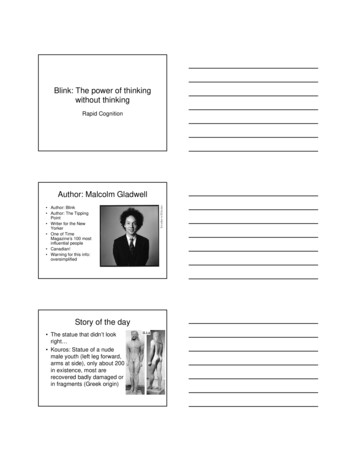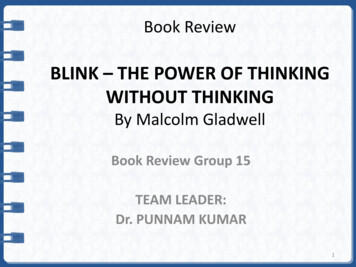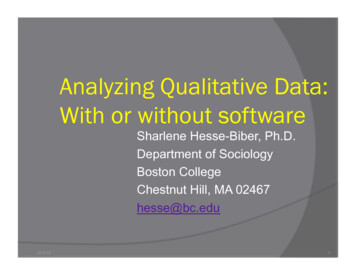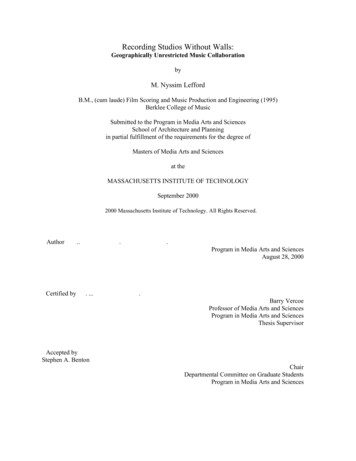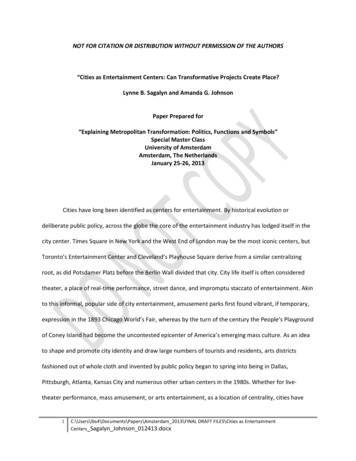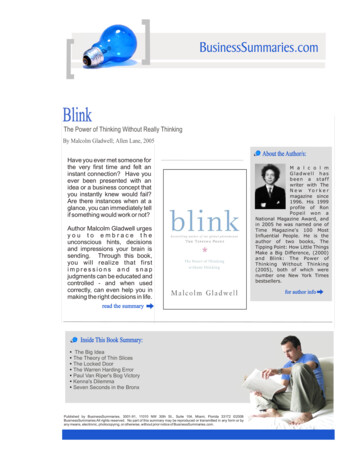
Transcription
BlinkThe Power of Thinking Without Really ThinkingBy Malcolm Gladwell; Allen Lane, 2005About the Author/s:Have you ever met someone forthe very first time and felt aninstant connection? Have youever been presented with anidea or a business concept thatyou instantly knew would fail?Are there instances when at aglance, you can immediately tellif something would work or not?Author Malcolm Gladwell urgesyou to embrace theunconscious hints, decisionsand impressions your brain issending. Through this book,you will realize that firstimpressions and snapjudgments can be educated andcontrolled - and when usedcorrectly, can even help you inmaking the right decisions in life.read the summaryInside This Book Summary:Ÿ The Big IdeaŸ The Theory of Thin SlicesŸ The Locked DoorŸ The Warren Harding ErrorŸ Paul Van Riper's Bog VictoryŸ Kenna's DilemmaŸ Seven Seconds in the BronxPublished by BusinessSummaries, 3001-91, 11010 NW 30th St., Suite 104, Miami, Florida 33172 2008BusinessSummaries All rights reserved. No part of this summary may be reproduced or transmitted in any form or byany means, electronic, photocopying, or otherwise, without prior notice of BusinessSummaries.com.M a l c o l mGladwell hasbeen a staffwriter with TheN e w Yo r k e rmagazine since1996. His 1999profile of RonPopeil won aNational Magazine Award, andin 2005 he was named one ofTime Magazine's 100 MostInfluential People. He is theauthor of two books, TheTipping Point: How Little ThingsMake a Big Difference, (2000)and Blink: The Power ofThinking Without Thinking(2005), both of which werenumber one New York Timesbestsellers.for author info
The Theory of Thin Slices: How a LittleBit of Knowledge Goes a Long WayThin slicing refers to the ability of theunconscious mind to find patterns in situationsand behavior based on very thin slices ofexperiences. It is about the gut feeling you mayhave upon meeting someone, or that hunch youstrongly feel when observing or learningsomething for the first time.It is through thin slicing that Dr. John Gottmancan accurately predict how a marriage will likelyturn out merely by observing a few minutes of acouple's conversation or a few hours of theirinteraction.According to Dr. Gottman, it is easy to spot apattern in how a person talks or how a coupleinteracts. Although these small nuances are notexplicit, they are there. And knowing how to lookfor them can give you hints on the outcome of aconversation, deal, friendship or partnership.The Locked Door: The Secret Life ofSnap DecisionsSnap thoughts and decisions happen so quicklythat you are sometimes not aware of them. InAbout the Book:Author: Malcolm GladwellPublisher: Allen LaneDate of Publication: 2005ISBN: 0713997273Number of Pages: 110 pagesBlink by Malcolm Gladwellfact, some of these thoughts and decisionsoccur in your unconsciousness. When thishappens, it takes some time for your “consciousbrain” to realize the significance of the snapdecisions.It is important to remember that snap thoughtsand feelings bubble up from the unconscious.These fleeting thoughts and decisions rely onthe thinnest slices of experience and take placebehind “locked doors”. In other words, theytake place beyond your consciousness and areoften times difficult to explain.You have to realize that you have two minds the conscious and the unconscious. In theevent that your conscious mind is blocked orstumped, your unconscious is scanning theroom, shifting through possibilities andprocessing every possible clue.Yourunconscious mind will then guide you, silentlyand surely, to the solution.The Warren Harding Error: Why We FallFor Tall, Dark and Handsome MenThe Dark Side of Thin SlicingThin slicing can be a powerful tool if you lookbeyond the surface and process informationcorrectly. Unfortunately, there is a dark side toquick cognition - The Warren Harding Error. Itis important to remember that even if thin slicingdoes help in making correct decision, it can alsolead a person astray.The Implicit Association Test (IAT)The Implicit Association Test (IAT) wasdeveloped by Anthony G. Greenwald, MahzarinBanaji and Brian Nosek. The IAT measures aperson's attitude on an unconscious level, or2 of 6
the immediate and automatic associations thatoccur even before a person has time to think.According to the test results, unconsciousattitudes may be totally different orincompatible with conscious values.Thismeans that attitudes towards things like race orgender operates on two levels:1. Conscious level - attitudes which areour stated values and which are used todirect behavior deliberately.2. Unconscious level - the immediate,automatic associations that tumble outbefore you have time to think.Clearly, this shows that aside from being ameasurement of attitudes, the IAT can be apowerful predictor of how one can act oncertain kinds of spontaneous situations.The Warren Harding ErrorMost people are prone to commit the WarrenHarding Error. They see someone (orsomething) and somehow they allow their firstimpressions to hide or obscure pieces ofinformation other than what is initially seen.Paul Van Riper's Bog Victory: CreatingStructure for SpontaneityA long time ago, Paul Van Riper, a retired Marinethat served the Vietnam War, was approached bya group of senior Pentagon Officials to take part inthe war game called Millennium Challenge '02.The stated purpose of Millennium Challenge '02was for the Pentagon to test a set of new and quiteradical ideas on battle warfare. In the war gamesscenario, Van Riper was asked to play the rougecommander of the red team. The United Statesand its allies are always known as the blue teamand the enemies as the red team.The war game was not just a battle between twoarmies. The war game was a battle between twoperfectly opposed military philosophies. The Blueteam had their databases, matrixes, andmethodologies for systematically understandingthe intentions and capabilities of the enemy. TheRed team, on the other hand, was led by a manwho is known for making instant decisions and notplaying by the rules.On the day of the “war”, the Blue team acted likeclockwork using their matrixes and databases toattack the Red team and render them totallydefenseless. The Blue Team acted with totalconfidence that their Operational Net Assessmentmatrixes were accurate in detecting Red'svulnerabilities and movements. But Van Riper'steam caught them completely by surprise and didnot behave like what the computer predicted.To lessen the chances of committing theWarren Harding Error, you have to fight againstbasing your actions and impressions solely onphysical appearance. Always remember thatfirst impressions are generated by yourexperiences and the environment. This meansthat you can change your first impressions bychanging the experiences that comprise theseimpressions.At the end of the game, the Blue team lost half oftheir troops.To take rapid cognition seriously, you mustacknowledging the incredible power that firstimpressions have in your life. You must takeactive steps to manage and control theseimpressions.The Perils of IntrospectionVan Riper's team won because it acted in a waythat caught the other team by surprise. The teamacted on instinct and improvisation and did notBlink by Malcolm Gladwell3 of 6
waste time discussing and gatheringinformation.Instead, the team relied on the wisdom, theexperience and the good judgment of everyoneon the team. Van Riper allowed his underlingsoperate without having to explain themselvesconstantly, thereby enabling rapid cognition.The Blue team, on the other hand, had longdiscussions. The Blue team was so focused onthe mechanics and the processes that theynever looked at the problem holistically.When Less is MoreRemember that sometimes extra information isnot helpful at all.Sometimes too muchinformation confuses rather than helps whenfinding a solution or making a decision.Truly successful decision making relies on abalance between deliberate and instructivethinking. Deliberate thinking is a wonderful toolwhen you have the luxury of time and a clearlydefined task.In good decision making, as well as in makingsnap judgments, less is more. Overloading thedecision makers with too much data andinformation makes decision-making harder andnot easier.Kenna's Dilemma: The Right - and WrongWay to Ask People What They WantThe rock musician known as Kenna is anexample of the sort of person who is constantlyat odds with your expectations. This is reflectedby his songs (which are hard to classify) and hiscareer (which was difficult to launch).People who truly know music love him. Theyhear one of his songs and in a blink of an eye,their instinct tells them that he is the kind of artistwhom other people are going to like. But this iswhere the problem comes in. Whenever there isBlink by Malcolm Gladwellan attempt to verify this instinct, such as a marketsurvey or research, the results turn out to bedisappointing.What seems to be the problem?Sensation TransferenceSensation Transference is a concept created byLouis Cheskin, one of the greatest figures in 20thcentury marketing. Cheskin was certain thatwhen people provide assessments of somethingthey might buy in a supermarket or a departmentstore, they unconsciously transfer sensations orimpressions they have about the packaging of theproduct or the product itself.Cheskin believed that most don't make adistinction - on an unconscious level - betweenthe package and the product. The product is theAbout the Author/s:Malcolm Gladwell has been a staffwriter with The New Yorkermagazine since 1996. His 1999profile of Ron Popeil won aNational Magazine Award, and in2005 he was named one of TimeMagazine's 100 Most InfluentialPeople. He is the author of twobooks, The Tipping Point: HowLittle Things Make a Big Difference, (2000) andBlink: The Power of Thinking Without Thinking(2005), both of which were number one New YorkTimes bestsellers.From 1987 to 1996, he was a reporter with theWashington Post, where he covered business,science, and then served as the newspaper's NewYork City bureau chief. He graduated from theUniversity of Toronto, Trinity College, with adegree in history. He was born in England, grewup in rural Ontario, and now lives in New York City.To know more about the author, go ?author number 3924 of 6
package and the product combined.The “New Coke” FiascoThe Coca-Cola Company came out with “NewCoke” in the 1980s as a response to the Pepsicommercial known as “The Pepsi Challenge”.In this commercial, dedicated cola drinkerswere asked to take a sip from two glasses, onemarked Q and one marked M. The sip testrevealed that most prefer the sweeter taste ofPepsi. When Coca-Cola conducted its ownmarket research, they came up with the sameresults.The Coca-Cola Company then launched a newand improved cola marketed as “New Coke”.Market research revealed that the taste wasmuch preferred over the old Coke - but the newproduct failed. Coke drinkers protested and thecompany was plunged into a crisis and wasforced to bring back the old formula.Coca-Cola's error is that they placed too muchemphasis on the sip tests without realizing thatthe entire principle of a blind taste test wasridiculous because in the real world, no oneever drinks Coca-cola blindfolded.It is important to realize that when making adecision, people not only rely on sensoryelements such as touch, taste, smell, andsound, but also sight,memory and theimagination. Thin slicing is done in context ofan experience or observation that is reinforcedin numerous activities and occasions.Market ResearchExecutives and decision-makers like marketresearch because it provides certainty. Marketresearch is a score or a prediction thatexecutives can point to if someone asks why hemade that decision was made.Unfortunately, few realize that in making themost important decisions, there can be nocertainty. This is the reason why musicianKenna did badly when he was subjected tomarket research. His music was new andBlink by Malcolm Gladwelldifferent, and being new and different is alwaysvulnerable to market research.The Gift of ExpertiseFirst impressions vary from one person to anotherand only people who are experts in their field areable to reliably account for their reactions. Theseexperts can express their first impressions andgut feels more accurately and more extensively.It does not mean that the reactions of peopleoutside their areas of passion and experience (i.e.not experts in a particular field) are always wrong.It just means that reactions from non-experts arehard to explain and easily disrupted.Through experience, you can become an expertat using your behavior and training to interpret anddecode what lies behind snap judgments and firstimpressions.Seven Seconds in the Bronx: TheDelicate Art of Mind ReadingFacial expressions assist in making snapjudgments and first impressions. If you failure toread and understand facial expressions and relyonly on your judgment based on stereotypes,mistakes (fatal or otherwise) can be made.Mind-reading failures happen to all. They are thecause of numerous arguments, disappointments,disagreements, misunderstandings and hurtfeelings. These failures are so immediate and somysterious that it is difficult to understand them.The Theory of Mind ReadingThe most common and important forms of rapidcog ni t ion are the judg m e n t s ma d e andimpressions from other individuals. When youtalk to someone, you look at the person's face(especially the eyes) to judge sincerity. When youmeet or talk to someone, you pick up subtle handand face signals that tell you if the person likesyou, and if he is being sincere or otherwise.Looking at a person's face during an interaction isa part of how one “thin slices” other people.5 of 6
The face is an extremely rich source ofinformation about impressions and is central tounderstanding on how mind reading works. Theface shows signals of what is going on inside themind of an individual. Emotion
About the Book: 2 of 6 The Theory of Thin Slices: How a Little Bit of Knowledge Goes a Long Way The Locked Door: The Secret Life of Snap Decisions The Warren Harding Error: Why We Fall For Tall, Dark and Handsome Men Blink by Malcolm Gladwell
